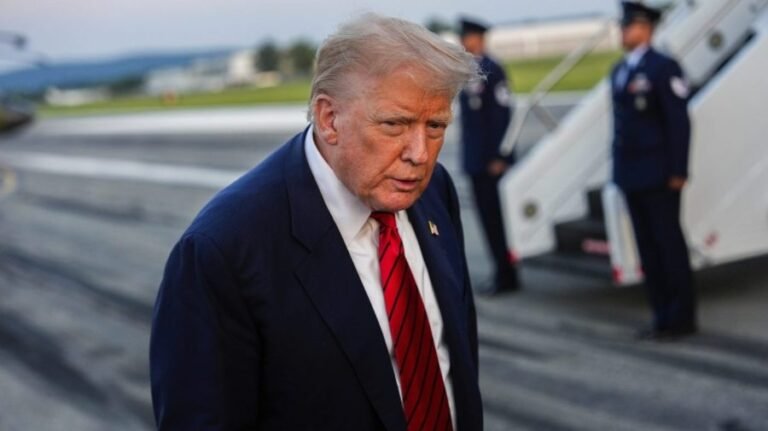
When President Trump began his Apr. 2 remarks in the Rose Garden, he declared it will be a day that is forever remembered. He then went on to announce the biggest round of tariff hikes in more than 100 years.
“Liberation Day,” however, won’t be remembered for the reasons Trump cited. In fact, the U.S. stock market reacted with its biggest selloff since 2020, while the U.S. dollar weakened against key currencies.
When Treasury yields surged at the start of this week, it raised concerns about a potential crisis situation. One day later, Trump announced a 90-day pause for reciprocal tariffs for all countries except China. Although Trump is now more flexible than before, the roller coaster ride in financial markets will not be over until the trade war is resolved.
The editorial board of the Wall Street Journal has called Trump’s tariffs “the biggest policy shock to the world trading system since Richard Nixon blew up Bretton Woods in 1971.” It was a landmark development that led to the first dollar devaluation and eventually to flexible exchange rates supplanting fixed exchange rates. The fallout was a prolonged period of financial market turbulence.
By comparison, the tariffs announced on April 2 effectively ended the post-war trading system that contributed to a rapid expansion of world trade and global economic growth. It was based on the principle of most favored nation, where the goal was to insure a system that was both global and non-discriminatory.
The post-war system was replaced by reciprocal tariffs that the U.S. Trade Representative derived by dividing a country’s bilateral trade surplus by its exports to the U.S. According to Peter Navarro, the bilateral surplus measures how “unfair” a country’s trading practices are.
The dilemma U.S. trading partners confront, however, is there are no agreed set of rules governing international trade. Each country is left to strike its own deal with the U.S., because President Trump disdains multilateral agreements.
Meanwhile, confidence readings for households and businesses have plummeted as higher tariffs are expected to slow U.S. economic activity considerably. The stock market selloff indicates investors were pricing in an increased risk of recession. Inflation is also expected to rise temporarily, raising the specter of stagflation.
As investors asses how the trade war will play out, my approach focuses on four key issues.
First, what is the nature of the shock and how might it evolve?
What makes the tariff shock different from other global shocks is it is stems from Trump’s core belief that U.S. trade deficits are the result of “unfair” trade practices of our principal trading partners. The bet he is making is they will capitulate when threatened with higher tariffs. However, his actions have led to an escalation in the conflict with China, and the EU has approved an initial round of tariffs that is now paused. At the same time, the U.S. dollar has weakened and Treasury yields have gyrated.
Second, what is the likely policy response if the U.S. economy weakens?
At its March meeting, the Fed kept monetary policy on hold, but it now faces the difficult task of deciding when to ease policy even if inflation picks up. Following the Apr. 2 announcement, the bond market was pricing in that the Fed would lower the funds rate by 125 basis points and end this year at 3.0 percent to 3.25 percent. If so, the Fed’s response would be less rapid than what occurred during the 2008 Financial Crisis and the COVID-19 pandemic.
U.S. fiscal policy is also likely to be more constrained than during those shocks. President Trump and Congressional Republicans are committed to reduce the size of the federal government and to curb federal spending. This leaves tax cuts as the only counter-cyclical policy lever to offset economic weakness. Accordingly, there is less reason to expect a V-shaped economic recovery this time
Third, what news is priced into markets?
Prior to the trade war, U.S. stock market valuations approached the record high during the tech bubble. While valuations have come off their peak, they are still high. Moreover, Wall Street analysts are just beginning to cut their forecasts for S&P 500 earnings from 15 percent at the start of the year. Goldman Sachs estimates that every 5 percentage point increase in the U.S. tariff rate could reduce S&P 500 earnings per share by as much as 2 percent. This does not factor in the downside if a recession materializes, which normally is accompanied by steep declines in earnings.
Fourth, how should investors weigh risks and rewards in positioning portfolios?
Initially, gold and U.S. Treasuries benefitted from being safe havens, while Trump’s policies caused global investors to diversify away from the dollar into the euro and Japanese yen. Equity investors have also been shifting allocations away from the U.S. stocks after they substantially outperformed international markets for many years. Previously, the widespread view was that overseas economies would be hurt more by tariffs than the U.S.
The big unknown is when the trade war will end. While some bilateral deals may be announced, the most important ones are with China and the EU and will take much longer. Meanwhile, across-the-board tariffs of 10 percent are in place, and duties for the largest trading partners of the U.S. are 125 percent for China and 25 percent for most goods from Canada and Mexico.
Finally, investors should keep in mind that the economic pain will become evident in the months ahead, and the consequences of the trade war will reverberate well beyond.
Nicholas Sargen, Ph.D., is an economic consultant who has been involved in international markets since the 1970s. He has written three books including Global Shocks: An Investment Guide for Turbulent Markets.


